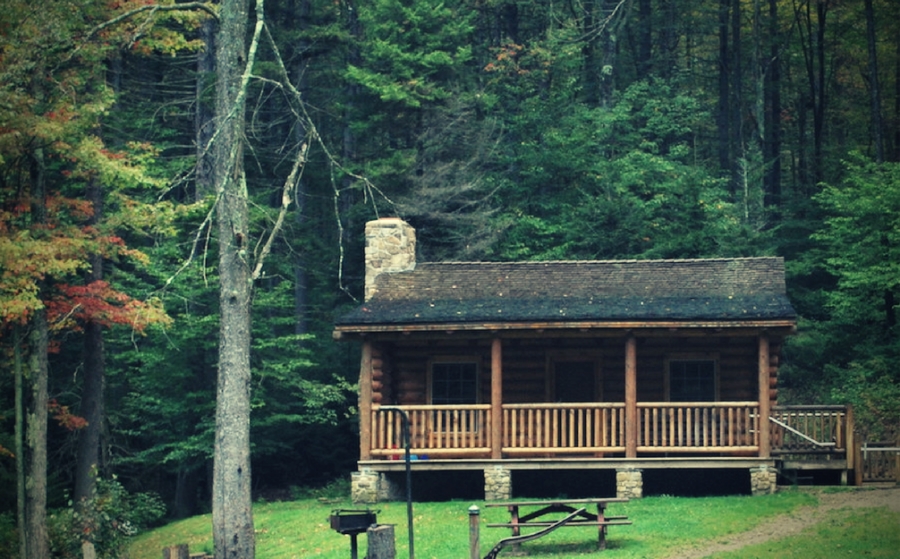As hard as it is to believe, winter is rapidly approaching, and along with it, some of the most time honored traditions of the entire year. Hot apple cider, fires in the fireplace, and yes, a getaway to that cabin in the woods.
For many of us, cabins have long represented freedom and possibility. The ability to connect with nature. The ability to escape and feel small. Cabins are the backdrop to some of the greatest laughs, the longest talks, and the most contemplative moments of our lives.
In recent years, one increasing trend promises buyers greater accessibility to the dream of cabin ownership--the cabin kit.
Cabin kits are billed as a quick, low-cost solution to putting a cabin on their property. Dozens of manufacturers across the United States and Canada offer complete lineups of varying cabin sizes (and prices), that buyers can choose from. Because these models are essentially “templated” and manufactured in a warehouse off-site, buyers are promised a significant cost savings over a custom cabin build. After a buyer selects their cabin kit and remits payment, their kit is packaged up and shipped to their location. Upon arriving, the kit is assembled on site by the homeowner or a contractor, just like that set of Legos you got as a kid for your birthday.
Sounds like a no-brainer right?
Well, as is often the case, along with the terrific upsides that cabin kits appear to offer, there are some significant drawbacks that buyers don’t realize (or simply choose not to acknowledge!). Here are a few of the most common:
- Permitting a cabin kit can take forever and suck the life out of you. Because permitting requirements vary with municipalities, it’s impossible for cabin kit manufacturers to truly create a “one size fits all” solution. What is allowed in one county, might be expressly verboten the next county over. Because of this, every permitting process is different, which essentially means that certain cabin kits may not work on your piece of property. While some manufacturers are willing to work directly with buyer municipalities to supply plans (and even modifications), other manufacturers leave the responsibility up to the homebuyer, requiring them to be the go between. Any changes that the municipality demands can mean more time or money out of the buyer pocket. The more time and expense required by customizations, the less overall value you get from the “templateness” of a cabin kit (Wait, aren’t these supposed to be the original reasons to build with a kit?).
- Bank loans are a near impossibility. Conventional financing relies heavily upon the opinion of an official appraisal. And in turn, appraisals depend heavily on the existence of “like for like” comparisons (“comps”). This makes financing for “alternative housing” extremely hard to get. And log cabin kits are no exception to this. Because there are still relatively few cabin kits across the country, securing conventional bank financing is a near impossibility for buyers. Many buyers, while initially lured in by a low price tag, fail to realize that cabin kits will not be an option for them unless they have cash. One caveat to this is that some manufacturers do offer their own in-house financing to qualifying applicants. Still, buyer be warned that the options for financing these types of builds are extremely lean.
- Costs not included in the sticker price. Even though a cabin “kit” is supposed to be an all-inclusive package to build your home, it’s simply not the case. Depending on the kit, buyers may not receive flooring, roofing, cabinetry, and other finishing touches. Electrical wiring, plumbing, heating or cooling, lighting, and other important home systems are usually purchased and installed separately. Essentially, buyers are paying for a “shell.” Couple these costs with other expenses from furniture and fixtures (often shown in manufacturer marketing, but obviously not included in the kit), and you have a healthy addition to the “all inclusive” price.
- Buyers are responsible for the foundation and site prep work. To the end buyer, some of the most often overlooked pieces of the real estate equation are the costs associated with site prep. Particularly with rural land, developing a home site to the point where it is liveable can be quite expensive. Clearing land, grading, leveling, creating a building pad and a driveway, and bringing utilities to a site can be tens or hundreds of thousands of dollars. If city utilities are a possibility, these can be delivered to the building site, but are costly. If municipal utilities are not available, then culinary wells, septic systems, and off-grid solar energy systems can be extremely expensive. And for buyers that think they can simply decide to “rough it”, think again. In addition to being necessary for creature comforts, many of these are required for permitting and again for final signatures.
- The building site might not even be accessible for the trucks to deliver a kit. Many buyers assume that because a friend or online associate was able to get their cabin kit delivered to their remote area, they will too. Don’t make the mistake of assuming! Sometimes the very features that make a property appealing, simultaneously create a logistical nightmare for delivering a cabin kit. Remoteness, terrain, heavily wooded areas, water features, incline, and other factors can be near prohibitive for a truck of any size. Once again, if a truck isn’t able to access your site, it will have to be delivered another way (Think: tractor, boats, pickup trucks, quads, etc). And you guessed it, this usually means more money.
- An ongoing maintenance nightmare. Unlike a 3/2 in the ‘burbs, cabins require a significant amount of upkeep and regular maintenance. Due to the fact that cabin kit manufacturers frequently use “kiln-dried” wood, a significant moisture content exists in shipped kits. After several years, buyers will notice structural warping of the cabin, meaning that flooring, doors, and window frames may not hold true to original construction. In addition to warping, all wood structures present an increased risk to fire and termite problems. Applying wood sealant, and other ongoing, regular maintenance tasks are absolutely vital if you want to maintain structural integrity.
- Till death do you part. Finally, buyers need to remember that while a cabin on a particular piece of property may be their dream, it may very well be ONLY their dream. Kit cabins on a remote piece of property (as well as any other cabin) can be much harder to sell than a traditional suburban residence. Why? There simply aren’t as many buyers in the cabin market! Cabin properties are typically further from jobs, families, and other urban amenities that people look for in purchasing real estate. All too often, buyers assume that they won’t ever want to sell a cabin, only to realize a few short years later, that they need to and can’t. Death, divorce, finances and family situations have a way of changing life in a hurry. Before signing on the line, buyers need to realistically consider how saleable their kit cabin will be, if they need to exit.
While these are just a few of the complications that can arise, they represent a cross-section of some of the more common cabin kit issues that rear their ugly heads. What are the solutions then? If cabin real estate is your ultimate goal, there are a few worth exploring.
- Search existing cabin real estate for sale. This one isn’t any secret, but as the old adage tells us, “prior performance is the best indicator of future success.” If you want to minimize some of the risks and downsides that come along with building a cabin from a kit, buying an existing structure is a great way to do it. Nobody is in a better position to help with this than a licensed REALTOR. Using location, price, and property criteria, a REALTOR can zero in on select properties for buyers to review. While the sticker price may be higher, the assurance of property inspections, and service history can be a comforting thing.
- Build with a reputable licensed contractor. If you have it in your heart to build your own cabin, but don’t want to mess with some of the above hassles of a kit, consider finding and hiring a contractor with a good track record, from a service like Angie’s List. Doing this allows you to tap into people with extremely solid local information. Builders in your area will have navigated the permitting waters with your municipality, and understand the needs of a home in your area--related to climate, building materials, etc.
- Go hardcore DIY and build your own cabin with real logs. If you are up for the DIY project of a lifetime, there are plenty of people out there that build their own homes, straight from the logs themselves. While you don’t skirt every issue above, the cost is a fraction of a kit cabin. According to the Log Home Builder’s Association, several of their students build homes from less than $10,000, all told. This essentially makes financing a non-issue as well. The LHBA also claims that real logs don’t experience the same warping and twisting that milled lumber does either. Forget the kits, and go full DIY!
It’s easy for buyers to get caught up in the promise of a low-cost, easy-to-assemble cabin, only to realize later that they bit off more than they can chew. While the allure is understandable, the potential ramifications of building with a kit cabin can be disastrous. With careful forethought and planning however, there are still several great options to get your own perfect cabin in the woods.








